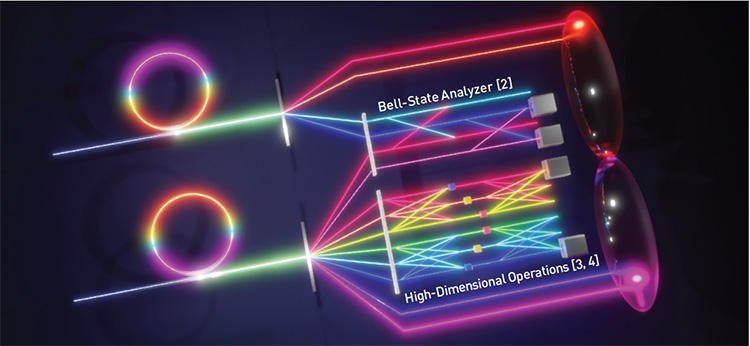 Conceptual illustration of frequency-multiplexed quantum networking operations. Bracketed numbers refer to references in text. [Y. Pai, ORNL]
Conceptual illustration of frequency-multiplexed quantum networking operations. Bracketed numbers refer to references in text. [Y. Pai, ORNL]
Unleashing the power of quantum technologies at scale will depend heavily on the realization of quantum networks that can connect many hybrid quantum devices and platforms, exploiting each of their respective advantages. Entangled-photon sources and the subsequent manipulations required to link multiple nodes are critical to optimize the connectivity of optical quantum networks.
Entanglement throughput can be further maximized by moving beyond single-frequency-mode entanglement distribution to a multiplexed environment. Among the variety of possible platforms for photonic quantum information, the frequency degree of freedom (DoF) has promising potential to deliver the aforementioned functionalities in a controllable fashion.1 In three studies this year, we have demonstrated a toolkit to realize fundamental quantum-networking functionalities with high-dimensional, frequency-encoded photons.
Consider a wavelength-multiplexed quantum network with quantum nodes operating at different frequencies. Unless extra measures such as fast detection and feed-forward corrections are implemented, entanglement swapping with these frequency-mismatched photons in a traditional Bell-state analyzer (BSA) will result in distinguishable outcomes and thus lower fidelity. We addressed this limitation and demonstrated a proof-of-concept BSA with interleaved frequency beam splitters synthesized on a quantum frequency processor (QFP),2 which naturally accommodates the distinct frequencies expected in a quantum internet compatible with spectral multiplexing.
Another advantage of the frequency DoF is its inherent high dimensionality. High-dimensional quantum states (qudits) offer crucial advantages such as higher information capacities and increased noise tolerance. Nevertheless, scaling to higher dimensions in many DoFs demands larger footprints.
For frequency encoding, we can circumvent this dilemma by exploring quantum frequency combs generated in a single microring resonator. Devising an efficient Bayesian tomographic technique that employs random modulation on a pulse shaper and phase modulator, we estimated the full quantum state of an on-chip quantum frequency comb in an 8×8-dimensional two-qudit Hilbert space—a record for frequency-bin encoding.3 Moving beyond just the measurement of frequency qudits to their coherent manipulation, we also developed a recipe for synthesizing discrete Fourier transform operations—valuable in a myriad of applications ranging from quantum key distribution to entanglement quantification—on a single QFP device.4
Optical frequencies can also serve as multiplexing channels to carry quantum information in another DoF, facilitating various bandwidth allocation and distribution schemes in quantum networks. Leveraging wavelength-selective switch technologies, we implemented flex-grid polarization entanglement distribution in a deployed quantum local area network (consisting of three buildings on the Oak Ridge campus)5 and performed remote state preparation—a crucial quantum communication protocol.
Taken together, our recent demonstrations highlight the exceptional flexibility of the frequency DoF for parallelized, high-dimensional and reconfigurable quantum networking—whether serving behind the scenes as channels for other DoFs, or stepping into the limelight as the quantum information itself.
Researchers
Hsuan-Hao Lu, Muneer Alshowkan and Nicholas A. Peters, Oak Ridge National Laboratory, Oak Ridge, TN, USA
Joseph M. Lukens, Oak Ridge National Laboratory, Oak Ridge, TN, and Arizona State University, Tempe, AZ, USA
Karthik V. Myilswamy and Andrew M. Weiner, Purdue University, West Lafayette, IN, USA
Navin B. Lingaraju, SRI International, Arlington, VA, USA
References
1. M. Kues et al. Nat. Photon. 13, 170 (2019).
2. N.-B. Lingaraju et al. Optica. 9, 280 (2022).
3. H.-H. Lu et al. Nat. Commun. 13, 4338 (2022).
4. H.-H. Lu et al. Opt. Express 30, 10126 (2022).
5. M. Alshowkan et al. PRX Quantum, 2, 040304 (2021).
